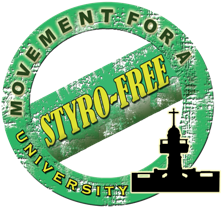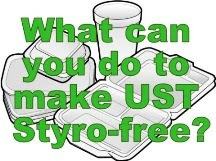Fact: The University of Santo Tomas produces at least twenty garbage bags full of Styrofoam packs a day.
This was based on a study conducted by the Office for Community Development (OCD) in coordination with different student organizations of the university, in cooperation with the City Service Corporation Janitorial Services. For five days, Styrofoam containers (food keepers and cups) were segregated in each of the buildings and placed in separate garbage bags.
The result? A hundred and seven (107) garbage bags of Styro packs—enough to fill four classrooms—were collected from nine areas of the University at the end of the week. When it comes to ‘going green’, UST has a long way to go.
As part of the University’s efforts to take an active role on the current environmental concerns, the Office for Community Development (OCD) is organizing a University-wide Styro-free campaign. The campaign initially aims to minimize the use of Styrofoam-based products within the university through a unified and conscious effort from the whole Thomasian community.
Last September 2008, the campaign was initiated through convening different student organizations from the high school to the college levels. A conceptualization meeting was held to introduce the campaign and share each other’s experiences, thoughts and ideas on minimizing the consumption of Styrofoam-based products. To jumpstart the campaign, it was suggested that the current Styro use first be monitored, after which, advocacy and intervention measures have to be undertaken. During the implementation of the campaign, Styro use will be continuously monitored—when the figures are cut by at least twenty per cent (20%) at the end of the first phase of the implementation period, and by fifty per cent (50%) in the latter phase—that means the campaign is effective. To make it a complete success, however, we must be able to cut more than that—and make the whole University Styro-free.
Mr. Peter Reyes Jr., Senior Supervisor, and Ms. Mila Ocon, Supervisor, along with the different Building Leaders of the City Service Corporation, agreed to the idea and set about to segregate and tally the number of Styro packs used. For five days from September 22-26, 2008—a week nearing final exams—the Janitorial Services personnel and the different student organizations observed Styro use, writing down how much Styro was put in the trash using a Daily Styro Monitoring Form similar to the Daily Waste Segregation Monitoring Form being used by the Janitorial Services. At the end of each disposal time, Styro packs were collected and put in separate garbage bags. On the average, a large plastic garbage bag contained a hundred (100) Styro units or packs.
The buildings and areas monitored were as follows: Roque Ruaño (Engineering), Albertus Magnus (Education), AMV-College of Accountancy, St. Martin de Porres (Medicine), St. Raymund de Peñafort (AB-Commerce), Main Building, Tan Yan Kee Student Center, Grounds, and Gardening. Note that the Beato Angelico (CFAD-Archi) and Benavides (High School) Buildings are not included here (these buildings do not fall under the jurisdiction of the City Services Corp.).
The student organizations and faculty members who convened during the conceptualization of the campaign were the Junior Philippine Institute of Accountancy, UST Mountaineering Club, Thomasian Junior Marketing Association, Earth-UST, UST-PURE, UST Education High School Student Council, UST High School Student Council, Central Student Council, Student Organizations Coordinating Council, Assoc. Prof. Arlen Ancheta, Prof. J.V. Ignacio, Prof. Crescencio Doma Jr., Prof. Alvin Ang, and Prof. Arlene de Leon. They are all now part of the Movement for a Styro-free University. With their initiative, the week-long monitoring of Styro use was conducted, and already there have been suggestions on what can be done to reduce the University’s Styro use.
Now that we know just how much Styro the University consumes, what’s next? Well, here now comes the hard part: advocacy and intervention. What intervention measures can be done to minimize Styro use? The easiest would have to be this: the success of the campaign depends on, first and foremost, ourselves.
The OCD, admitting to notorious large-scale Styro use during activities and trainings, started with a no-Styro policy in its events. The Pistang Tomas conducted in December did not make use of any Styro-based products whatsoever, earning for the event the “Styro-free seal”. The OCD hopes student organizations will do the same, conducting meetings and activities without Styro food packs. Or, as an individual student, to avoid (or as a start, to lessen) buying food that comes in Styro containers.
The College of Nursing has a designated classroom for students who bring their lunches to school—this dining area reduces the need to buy from nearby food establishments, therefore also reducing the waste produced from ‘take-out’ bags—Styro packs and plastic spoons and forks, not to mention the plastic bag itself. Bringing one’s own food container is ‘in’.
More participatory intervention measures have to be undertaken by the whole Thomasian community—students, faculty, non-teaching staff, and administration—to further this advocacy. The Office for Community Development is simply the convenor; we are looking up to the students and administration as the implementers.
Part of the campaign involves conducting research. Aside from doing case studies on Styro use, the campaign encourages research on alternative “eco-friendly” packaging for food. Starchware, made up largely of cornstarch and other bio-degradable materials, is another food packaging product out in the market today, in addition to carton and paper plates. Starchware is however, more expensive than Styro—if concessionaires are convinced to use these, the food products would no doubt cost more. What now?
An information drive about the pros and cons of Styro use will also be put into action, implemented by the student organizations who have become part (and who also want to be a part) of the Movement for a Styro-Free University. The info drive will make students more aware of the campaign, and also offer important facts and suggestions for cutting down Styro use.
During the conceptualization meeting, an interesting question was raised: Is it possible to bring one’s own food container or tumbler and ask for a discount from the food establishments if this is used as an alternate ‘plate’ or cup? For example, instead of being placed in Styro, your order of tapsilog will be placed in your own reusable “baunan”, and instead of paying the full price, you’ll get a discount of, say, at least one peso. Not only do you get to save some cash (because that is still around two hundred pesos a year), you also do your part in caring for the environment.
The Office for Community Development encourages students, and all Thomasians alike, to come up with thoughts about the issues raised here, suggestions (better if it’s being done already!), and ideas about the campaign. Let’s concentrate on minimizing Styro use within the University for now (plastic products are next!), and soon, we’ll be on our way to a greener, more environment-caring Thomasian community.
For more information on the campaign and the Movement for a Styro-Free University, you may contact Ms. Lauren Villarama ("Ate Orya") of the Office for Community Development.






0 comments:
Post a Comment